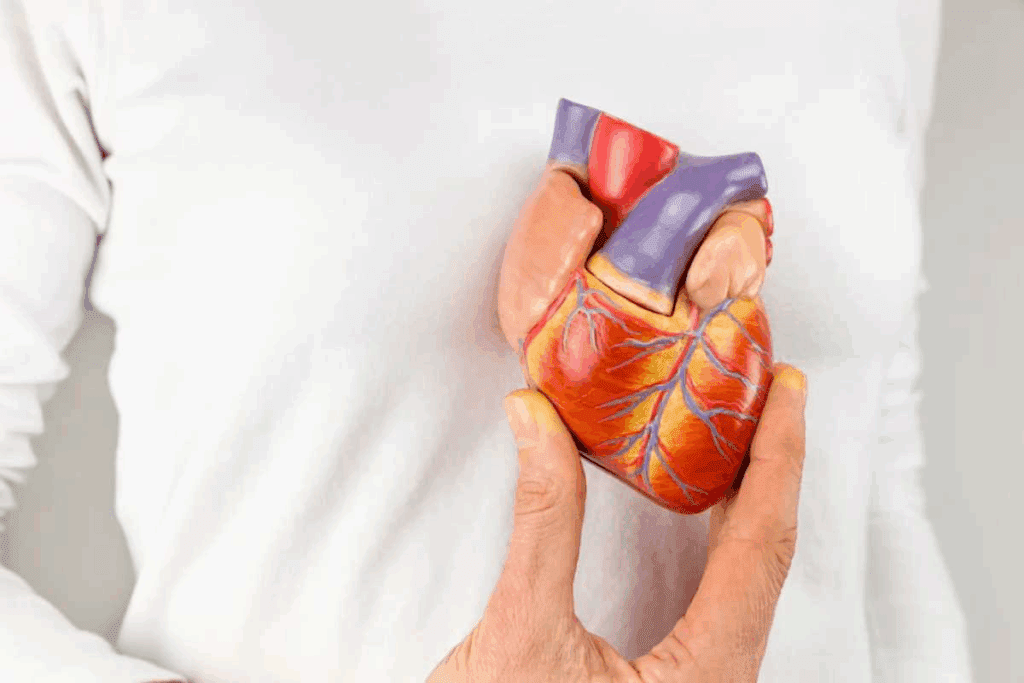
Congestive heart failure (CHF) happens when the heart can’t pump enough blood. This leads to fluid buildup and symptoms like dyspnea and edema. When the heart fails, fluid in the lungs causes shortness of breath.
Understanding the connection between CHF cardiac output and exacerbations of heart failure is key. At Liv Hospital, we use the latest research to guide our care. This approach earns the trust of patients looking for top-notch heart failure management.

Congestive heart failure (CHF) affects millions worldwide. It happens when the heart can’t pump enough blood. This is a big challenge in heart health, affecting patients, doctors, and the healthcare system.
CHF is a condition where the heart can’t pump blood well. Symptoms include dyspnea, fatigue, and peripheral edema. These symptoms vary based on the cause, severity, and if it’s acute or chronic.
Experts say diagnosing CHF is hard because symptoms are not specific. A full assessment is needed (Source: StatPearls). The heart’s reduced pumping ability causes these symptoms.
CHF is becoming more common worldwide. About half of those affected have heart failure with preserved ejection fraction (HFpEF). In 2017, there were 1.2 million hospitalizations for CHF, with more HFpEF cases than before.
| Year | Hospitalizations due to CHF | Percentage with HFpEF |
| 2015 | 1.1 million | 45% |
| 2016 | 1.15 million | 47% |
| 2017 | 1.2 million | 50% |
The impact of CHF on healthcare systems is huge. Knowing about CHF’s incidence, prevalence, and symptoms is key. It helps in finding better ways to manage and prevent it.
Dealing with CHF requires a detailed approach. By understanding its definition, symptoms, and global impact, we can improve care. Early diagnosis, effective management, and prevention are essential.

Cardiac output is key in congestive heart failure (CHF). We’ll look at how it works, what happens in CHF, and how it’s measured.
In a healthy heart, cardiac output is how much blood it pumps each minute. It depends on heart rate and how well the heart contracts. It’s vital for blood flow to the body. The heart adjusts to meet the body’s needs.
In CHF, the heart can’t pump blood well. This lowers cardiac output, causing organs to not get enough blood. CHF also involves changes in the heart and nervous system, making it harder for the heart to work.
The heart tries to compensate by working harder. But this makes things worse over time.
It’s important to measure cardiac output accurately in CHF. There are many ways to do this, like using catheters or echocardiography. Tracking cardiac output helps doctors see if treatments are working.
Understanding CHF is key to finding good treatments. CHF’s path involves complex body responses and heart changes. These lead to two main types: heart failure with preserved ejection fraction (HFpEF) and reduced ejection fraction (HFrEF).
In CHF, the body tries to keep the heart working by activating certain systems. The renin-angiotensin-aldosterone system (RAAS) and the sympathetic nervous system are key. At first, they help, but they can also make the disease worse over time.
The RAAS kicks in when the kidneys don’t get enough blood, causing blood vessels to narrow and holding onto sodium. The sympathetic nervous system also gets active, making the heart beat faster and stronger. But, staying active too long can harm the heart, causing scarring and thickening.
Ventricular remodeling is a big part of CHF. It’s when the heart changes size, shape, and function due to long-term stress. This can make the heart work worse and make symptoms worse too.
Remodeling can make the ventricle either thicker or bigger. Thickening, or hypertrophy, makes the wall of the ventricle thicker. Bigger, or dilatation, makes the ventricle chamber larger. Both can hurt how well the heart works and make CHF worse.
CHF is divided into two types based on how well the heart pumps: HFpEF and HFrEF. HFpEF has normal ejection fraction but poor diastolic function. HFrEF has a lower ejection fraction and poor systolic function.
Knowing the difference between HFpEF and HFrEF helps doctors choose the right treatment. HFrEF often comes from heart disease and heart attacks. HFpEF is more linked to high blood pressure and diabetes.
| Characteristics | HFpEF | HFrEF |
| Ejection Fraction | Normal or Preserved | Reduced |
| Primary Dysfunction | Diastolic Dysfunction | Systolic Dysfunction |
| Common Causes | Hypertension, Diabetes | Coronary Artery Disease, Myocardial Infarction |
Heart failure gets worse when the body’s fixes don’t work anymore or when something else makes it harder for the heart to pump. Knowing how CHF works is key to managing it well and stopping it from getting worse.
Congestive Heart Failure (CHF) has many causes. These include different heart conditions that make it hard for the heart to work right. Knowing what causes CHF is key to treating it well.
Coronary artery disease is the top reason for CHF globally. It damages the heart muscle, leading to heart failure. Spotting and treating coronary artery disease early is vital to stop CHF.
A study found that coronary artery disease causes about 60-70% of CHF in rich countries. This shows we need strong ways to stop coronary artery disease to lower CHF rates.
Hypertension is a big risk for CHF. It makes the heart work too hard, leading to heart failure if not managed. Keeping hypertension under control is essential to avoid CHF.
Valvular heart diseases, like mitral regurgitation and aortic stenosis, can also cause CHF. They make blood flow abnormally and increase heart work. Surgery or new treatments might be needed to fix these problems.
Cardiomyopathies, like dilated, hypertrophic, and restrictive types, are big CHF causes. They harm the heart muscle, making it hard to pump blood.
Other CHF causes include diabetes, obesity, and infections or toxins that harm the heart.
“The complex interplay of various factors in CHF etiology necessitates a comprehensive approach to diagnosis and treatment,” as noted by recent clinical guidelines.
It’s important to know all the different causes of CHF. This helps doctors create treatment plans that fit each patient’s needs.
It’s important to know what causes heart failure to get better at managing it. Heart failure gets worse when the heart can’t pump enough blood. This is a big problem.
Many things can make heart failure worse. These include:
Table 1: Common Precipitating Factors for Heart Failure Exacerbations
| Precipitating Factor | Description | Impact on Cardiac Output |
| Infection | Increased metabolic demand | Decreased |
| Arrhythmia | Irregular heart rhythm | Compromised |
| Non-adherence to medication | Inadequate symptom control | Reduced |
When heart failure gets worse, several changes happen. These include more fluid buildup, more stress on the heart, and the heart pumping less effectively.
The changes during a heart failure episode start a cycle. The heart pumps less, which makes it pump even less, making symptoms worse. This can lead to a serious breakdown.
It’s key to understand this cycle to manage heart failure better. By tackling the causes and using the right treatments, we can help the heart pump better and reduce these episodes.
Understanding the link between CHF cardiac output and exacerbations is key to managing heart failure well. We must explore how lower cardiac output leads to worse symptoms. We also need to look at the changes in blood flow and pressure during these episodes.
When CHF patients have lower cardiac output, it sets off a chain of events leading to worse symptoms. The heart’s inability to pump well causes blood to back up in veins. This raises venous pressure, leading to fluid buildup in lungs and tissues, causing breathing problems and swelling.
Key factors that contribute to reduced cardiac output include:
During acute decompensation, several changes happen that worsen cardiac output. These include higher systemic vascular resistance, lower heart muscle contractility, and changes in how well the heart can stretch.
| Hemodynamic Parameter | Change During Acute Decompensation | Clinical Impact |
| Cardiac Output | Decreased | Reduced perfusion of vital organs |
| Systemic Vascular Resistance | Increased | Increased afterload, further reducing cardiac output |
| Venous Pressure | Increased | Fluid accumulation in lungs and peripheral tissues |
The effects of worsening cardiac output in CHF patients are serious. They include more illness, lower quality of life, and higher risk of death. Also, worsening cardiac output can start a cycle where symptoms get worse, leading to even more decline.
We must understand the complex relationship between CHF cardiac output and exacerbations to manage heart failure well. By knowing the changes in blood flow and pressure, and the effects on patients, healthcare providers can create better plans to improve cardiac output and lessen exacerbations.
Diagnosing heart failure and identifying when it gets worse needs a deep understanding of clinical criteria and advanced diagnostic tools. We will look at how to diagnose heart failure, which is key for managing it well and improving patient care.
Diagnosing heart failure starts with checking clinical criteria and physical signs. Symptoms like shortness of breath, tiredness, and swelling are common. Physical checks, like looking at the jugular vein, listening for a specific heart sound, and checking for swelling, help figure out how severe it is.
The Framingham Heart Study criteria are used to diagnose heart failure. They include major and minor criteria. Major criteria, like waking up short of breath or high jugular venous pressure, along with minor criteria like swelling or an enlarged liver, help confirm the diagnosis.
Laboratory tests are key in diagnosing heart failure. Biomarkers like B-type natriuretic peptide (BNP) or N-terminal pro-b-type natriuretic peptide (NT-proBNP) are high in heart failure patients. These tests help diagnose. Other tests, like blood counts, electrolytes, and kidney function tests, help find causes and measure how severe it is.
Imaging studies, like echocardiography, are vital for looking at the heart’s structure and function. Echocardiography shows the heart’s pumping ability, valve function, and other issues. In some cases, cardiac MRI or CT scans are used to look at the heart’s anatomy and function more closely.
Assessing hemodynamics is important in managing heart failure, mainly in sudden worsening. Techniques like pulmonary artery catheterization give direct readings of heart output, lung artery pressures, and other vital signs. These readings help guide treatment and improve outcomes.
The following table summarizes the key diagnostic approaches for heart failure:
| Diagnostic Approach | Description | Key Findings |
| Clinical Criteria | Assessment of symptoms and physical findings | Dyspnea, fatigue, edema, jugular venous distension |
| Laboratory Tests | Biomarkers and other laboratory tests | Elevated BNP or NT-proBNP, abnormal electrolytes |
| Imaging Studies | Echocardiography and other imaging modalities | Reduced LVEF, valvular abnormalities |
| Hemodynamic Assessment | Pulmonary artery catheterization | Cardiac output, pulmonary artery pressures |
To help CHF patients, we need to boost their heart’s output and stop bad episodes. We use medicines, devices, and changes in lifestyle to do this.
Medicines are key in treating CHF. ACE inhibitors and beta-blockers help the heart work better. They also cut down on hospital stays. Diuretics help with too much fluid, a common problem.
Angiotensin receptor-neprilysin inhibitors (ARNI) are also promising. They help the heart and reduce bad episodes. The right medicine depends on the patient’s condition.
Devices like cardiac resynchronization therapy (CRT) and implantable cardioverter-defibrillators (ICDs) help too. CRT makes the heart beat in sync. ICDs prevent sudden heart deaths.
Changing how we live is also important. Eating less salt, exercising, and watching fluid intake are key. Quitting smoking and drinking less alcohol are good too. Teaching patients helps them stick to these changes.
By using medicines, devices, and lifestyle changes, we can make CHF patients’ hearts work better. This reduces bad episodes.
Keeping cardiac output stable is key to avoiding worsening heart failure and better outcomes for patients. We’ve looked into how CHF affects cardiac output and the risk of heart failure getting worse. To manage CHF well, we need to use medicines, devices, and changes in lifestyle to keep cardiac output right.
It’s vital to understand how CHF works and how it lowers cardiac output. By watching cardiac output closely and acting fast on any changes, doctors can lower the chance of heart failure getting worse. Our talk shows how important it is to tackle CHF from all angles. We need more research and to teach patients more to improve their care.
Congestive heart failure happens when the heart can’t pump blood well. This leads to less blood being pumped out. This problem makes the disease worse and can cause sudden bad episodes.
Heart failure often comes from heart disease, high blood pressure, valve problems, or muscle issues in the heart. Knowing why it happens helps doctors treat it better.
When the heart pumps less, it gets worse. This can happen because of infections, heart rhythm problems, or not taking medicine as told. It starts a cycle of worsening heart function.
Doctors use symptoms like trouble breathing and feeling tired. They also look for swelling and check heart function with tests. These help figure out if heart failure is getting worse.
Doctors use echocardiograms, special tests, and other methods to check heart pumping. These tools help see how bad the heart failure is and guide treatment.
Doctors use medicines like ACE inhibitors and beta-blockers. They also use devices and change lifestyle habits. This helps the heart pump better and avoid getting worse.
HFpEF has normal pumping but trouble relaxing the heart. HFrEF has less pumping because of muscle weakness. Knowing this helps doctors find the right treatment.
When the heart pumps less, the body tries to fix it with hormones and nerves. But these efforts can actually make the heart failure worse over time.
When the heart pumps less, it can lead to more serious problems. This includes more hospital stays and a lower quality of life. It also means a higher risk of death.
To stop heart failure from getting worse, doctors and patients must work together. This includes taking medicine as directed, making healthy lifestyle choices, and watching for signs of trouble. Quick action is key.
National Center for Biotechnology Information. (2025). What Is the Relationship Between CHF Cardiac Output. Retrieved from https://www.ncbi.nlm.nih.gov/books/NBK430873/
Subscribe to our e-newsletter to stay informed about the latest innovations in the world of health and exclusive offers!
WhatsApp us